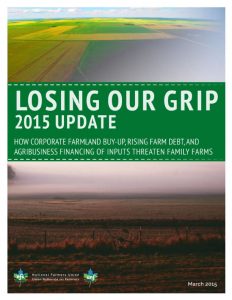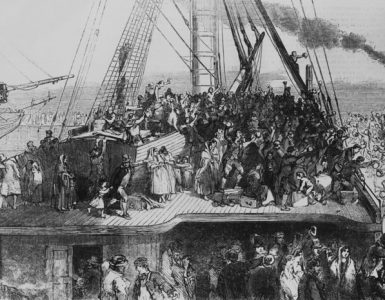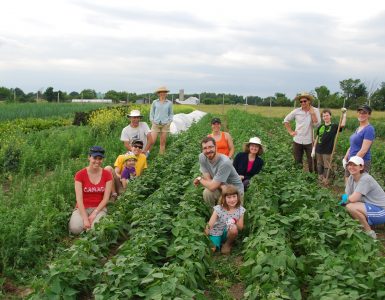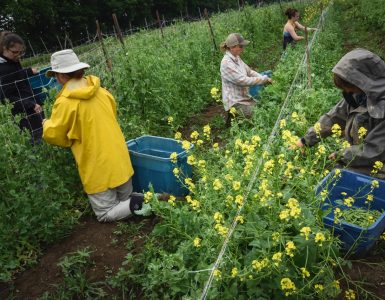You can see the best farmland in Canada from the top of the CN Tower. Or rather, what’s left of it.
Over half of Canada’s Class 1 farmland—the very best—is in Ontario. And about one third of Canada’s Class 1 farmland is visible from the top of the CN Tower, according to the Farmland Preservation Research Project at the University of Guelph.
Which means much of the best farmland is already covered by skyscrapers, highways, houses, parking lots, shopping malls, and industry.
Some people have the impression that, because Canada is so big, the amount of farmland is basically infinite. The classic image of the prairie is a field of waving wheat, seemingly endless and extending into the horizon.
The truth is very much the opposite. Only about 5 percent of the land area in Canada can actually sustain farming. And the very best of that farmland is the land in the most danger.
It’s the paradox of settlement. Colonial settlements were often established in the areas with the best farmland.
These areas had excellent topsoil that took thousands of years to build. That topsoil growth was encouraged by indigenous peoples, many of whom were prolific farmers and who bred new crops—corn, beans, squash, tomatoes—that we take for granted.
Those European settlements with access to the highest quality farmland grew fastest. Especially once they became industrialized, they gobbled up and destroyed the very farmland that sustained them in the first place. Toronto is the most severe example, but many cities followed the same pattern.
The loss of farmland to development is non-reversible—at least in our lifetimes—since topsoil creation is a process that takes thousands of years.
Between 2001 and 2011, Canada lost nearly a million hectares of its Class 1, 2, and 3 farmland. That’s an area nearly 16 times as large as the City of Toronto. Every day in Ontario we lose over 350 acres of farmland.
The expansion of suburbs, cities, and industry are the main culprits. But loss of farmland isn’t the only problem. This expansion has meant that the price of farmland is skyrocketing, in part because of land speculators and investment firms who buy up land in hopes of driving up the price so they can later flip the land for huge profits.
 According to the National Farmers Union’s 2015 Losing Our Grip report, the price of farmland has nearly doubled in Ontario since 2008. This forces farmers—who actually want to keep farmland as farmland—to go into massive debt as they compete with speculators and wealthy urban buyers. In particular, according to the NFU’s Losing Our Grip, investment funds and corporations both foreign and domestic are buying up billions of dollars of Canadian farmland. Farmland ownership is becoming ever more consolidated.
According to the National Farmers Union’s 2015 Losing Our Grip report, the price of farmland has nearly doubled in Ontario since 2008. This forces farmers—who actually want to keep farmland as farmland—to go into massive debt as they compete with speculators and wealthy urban buyers. In particular, according to the NFU’s Losing Our Grip, investment funds and corporations both foreign and domestic are buying up billions of dollars of Canadian farmland. Farmland ownership is becoming ever more consolidated.
Greenbelts and initiatives like the Ontario Farmland Trust are good efforts to save farmland. But they are limited by their funding and—in the case of greenbelts—their geographic scope. If we want to protect our farmland as a society—if we want to make sure that we can actually feed people in a future of global warming and rising food costs—we have to change the way we think about farmland.
The NFU’s Losing Our Grip recommendations include better support for intergenerational farmland transfers (so young farmers don’t have to incur massive debt), as well as restrictions on loss of land to industrial or residential uses.
These are great recommendations. But if we want to see these and other changes come into effect, regular people have to see farmland preservation as a real priority.
Because of the ageing of Canadian farmers, we are at a point of enormous transition. According to Food Secure Canada, 74% of farmers plan to sell their farms in the next ten years. If we don’t act, most of that land could be gobbled up by land speculators and corporations who want to profit by driving up prices at the expense of young farmers, our ecology, and our food security.
Farmers and eaters alike have to stand together against this devouring of farmland for profit. And we have to make it clear—to land speculators and lawmakers alike—that this practice is unacceptable, and that we will take a stand against it.
Aric McBay is a farmer and author. He lives and works at a mixed family farm with a dairy herd and a Community Shared Agriculture (CSA) vegetable operation.







